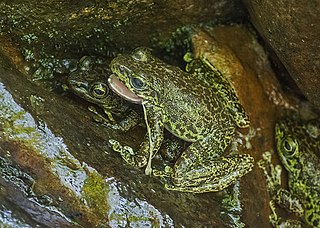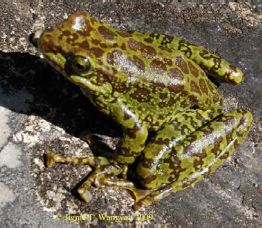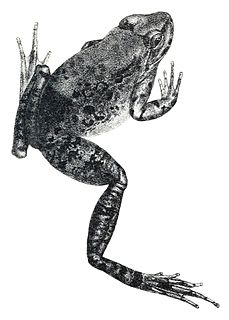
Amolops is a genus of true frogs native mainly to eastern and south-eastern Asia. These frogs are closely related to such genera as Huia, Meristogenys, Odorrana, Pelophylax and Rana, but still form a distinct lineage among the core radiation of true frogs. They are commonly known as "torrent frogs" after their favorite habitat - small rapid-flowing mountain and hill streams - but this name is used for many similar-looking frogs regardless of whether they are loosely related.

Meristogenys is a genus of true frogs from Borneo. Its tadpoles are adapted to fast-flowing mountain streams and easily recognizable by their divided upper lip with ribs on the outside.

Amolops formosus, also known as Assam sucker frog, beautiful stream frog, Assam cascade frog, or hill stream frog, is a species of frog found in high gradient streams of northern India, northern Bangladesh, and Nepal, possibly also Bhutan, although these records may represent confusion between Amolops himalayanus and this species; the latest available IUCN assessment from 2004 treats A. himalayanus as a synonym of A. formosus.

Amolops jaunsari, also known as the Jaunsar stream frog or Jaunsar's torrent frog, is a species of frog endemic to India. It is only known from its type locality near Chakrata in Uttarakhand. It was described based on a single specimen collected in 1985 and has not been recorded ever since.

Amolops larutensis is a species of frog in the family Ranidae that is found in the Malay Peninsula from southernmost Thailand to Malaysia; records further north probably represent A. panhai.
Amolops loloensis is a species of frog in the family Ranidae that is found in southern and western Sichuan and one locality in north-central Yunnan, China. Its natural habitats are small mountain streams in forests and grasslands. It is threatened by infrastructure development for human settlement, potentially also by water pollution from the mining industry. T

Amolops mantzorum, commonly known as the Sichuan torrent frog or Kangting sucker frog, is a species of frog in the family Ranidae. It is found in Gansu, Sichuan, and Yunnan Provinces of China. It has recently been reported also from Bhutan.
Amolops medogensis is a species of frog in the family Ranidae, the "true frogs". It is endemic to Mêdog County in southeastern Tibet, China; its range might extend into the adjacent Arunachal Pradesh, India. Common name Medog torrent frog has been proposed for it.

Amolops ricketti is a species of frog in the family Ranidae that is found in southern and eastern China and northern and central montane Vietnam.
Amolops torrentis is a species of frog in the family Ranidae that is endemic to China: it is only known from Hainan, with one isolated record from Guangdong in the Chinese mainland.

Amolops mengyangensis is a species of frog in the family Ranidae. It is known with certainty only from its type locality, the eponymous Mengyang in Xishuangbanna Dai Autonomous Prefecture, southern Yunnan province of China. However, if Amolops daorum is its junior synonym, distribution of Amolops mengyangensis would be considerably wider, including the vicinity of Sa Pa in northern Vietnam near the Chinese border, Hong Kong, and Houaphanh Province in eastern Laos, and presumably also including the intervening areas. This more inclusive species circumscription was taken in the latest assessment of this species for the IUCN Red List of Threatened Species from 2008.
Meristogenys amoropalamus is a species of frog in the family Ranidae. It is endemic to northern Borneo and occurs in northwestern Sabah and northeastern Sarawak (Malaysia) and in northeastern Kalimantan (Indonesia). Common names mountain Borneo frog and mountain torrent frog have been coined for it. Studies of its larvae revealed that the nominal species contained two cryptic forms, and in 2011, Shimada and colleagues described Meristogenys dyscritus as a separate species.
Meristogenys macrophthalmus is a species of frog in the family Ranidae. It is endemic to Sarawak in northern Borneo (Malaysia) and is only known from its type locality in the Bintulu District. The specific name macrophthalmus is derived from the Greek words macros (="large") and ophthalmos (="eye") and refers to the large eyes of this frog. Common names Matsui's Borneo frog, large-eyed torrent frog, and big-eyed torrent frog have been coined for it.

Nanorana blanfordii is a species of frog in the family Dicroglossidae. It is found in northeastern India, southern Tibet (China), and eastern Nepal, and likely in the adjacent western Bhutan. The specific name blanfordii honours William Thomas Blandford, a British geologist and zoologist.

Nanorana liebigii, also known as Sikkim paa frog, Liebig's paa frog, Liebig's frog, and spiny-armed frog, is a species of frog in the family Dicroglossidae. It is found in the Himalayas, specifically in Bhutan, southern Tibet (China), northern India, and Nepal. The specific name liebigii honours a certain "Dr von Liebig Jr.", likely referring to Justus von Liebig, German botanist and chemist.
Amolops daorum is a species of frog in the family Ranidae. It is known from its type locality in the vicinity of Sa Pa in northern Vietnam near the Chinese border, Hong Kong, and Houaphanh Province in eastern Laos; presumably it also occurs the intervening areas. The Hong Kong record is considered suspicious, however. Moreover, some sources, notably the IUCN Red List of Threatened Species, regard this species as a junior synonym of Amolops mengyangensis.
Odorrana exiliversabilis is a species of frogs in the family Ranidae that is endemic to southeastern China where it is found in Fujian, western Zhejiang, and southern Anhui provinces. These frogs can be found in mountain forest streams and are common in suitable habitat. The species is not considered threatened by the IUCN.
Odorrana junlianensis, also known as the Junlian odorous frog, is a species of frogs in the family Ranidae. It is found in southern China and in the northernmost Laos and Vietnam. Its type locality is the eponymous Junlian County in Sichuan.
Limnonectes bannaensis is a species of frogs in the family Dicroglossidae. It is found in southern China, Laos, Thailand and Vietnam.
Amolops akhaorum is a species of true frogs discovered in 2007 in the Nam Ha National Protected Area, north-western Laos. It is still only known from its type locality. The specific name akhaorum refers to the local Akha people who helped with the fieldwork of the team who discovered the species.










